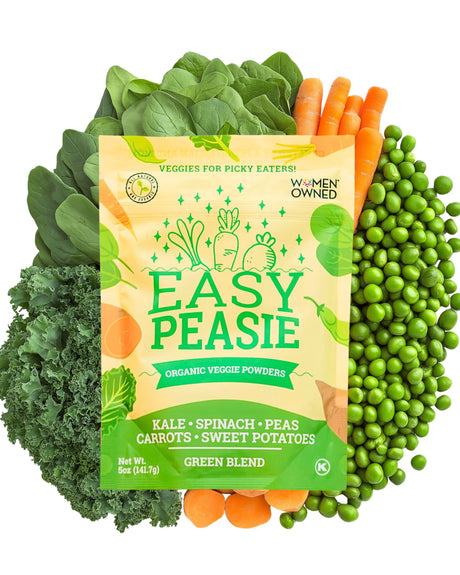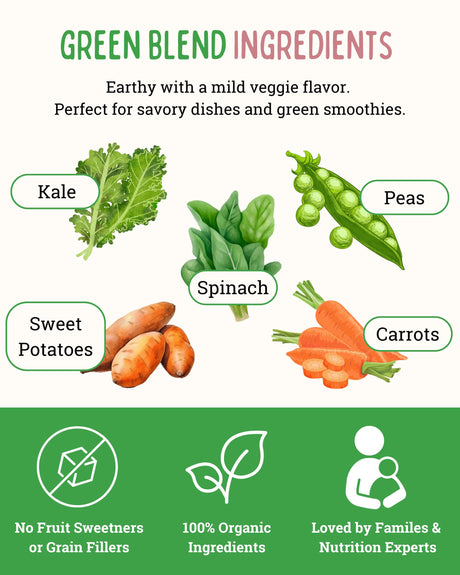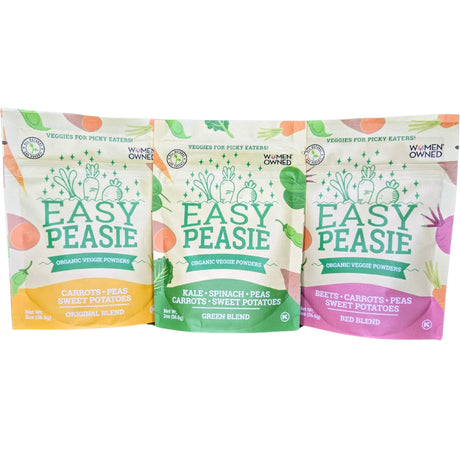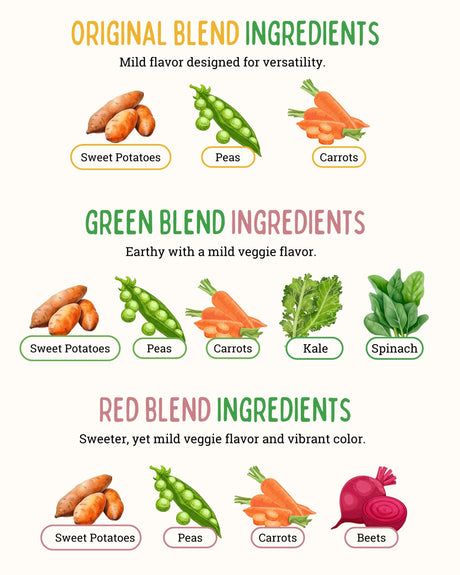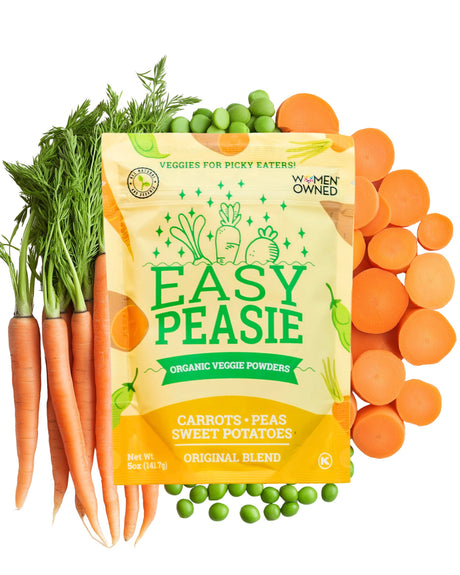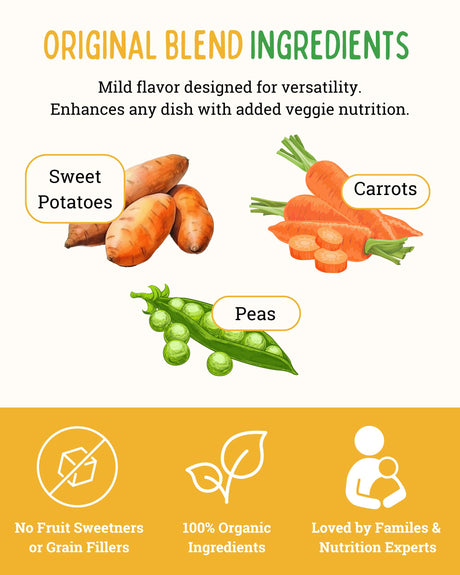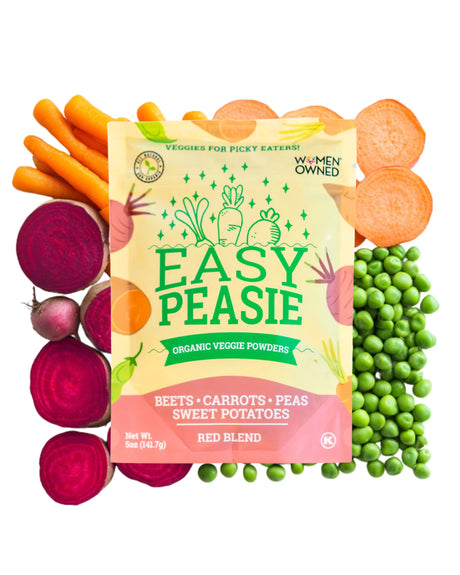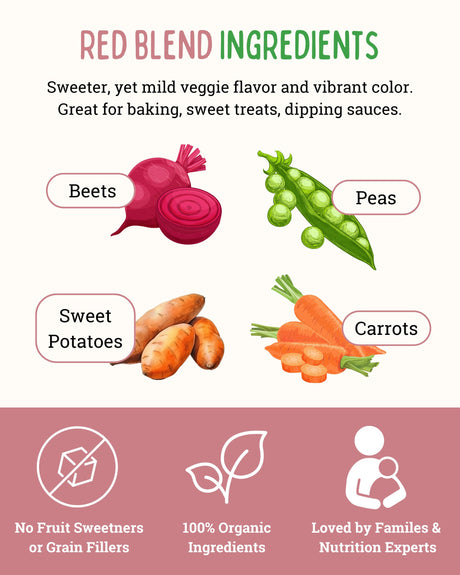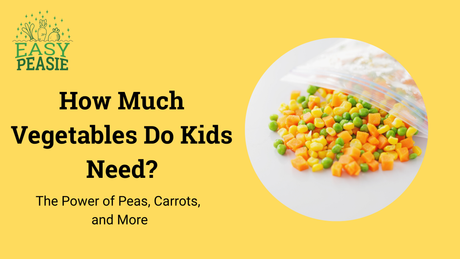Welcome to many parents’ common challenge—turning the picky eater at your table into a veggie-lover! It’s a journey familiar to many, filled with ups and downs, as we all strive to nourish our children not just with food, but with healthy habits that last a lifetime.
Vegetables, essential for their nutritional value, often become the battleground.
Why focus on vegetables? Simply put, their health benefits are undeniable, packed with vitamins, minerals, and fibers necessary for growth, development, and long-term health.
Yet, many parents encounter a fork in the road when their little ones flat-out refuse anything green or leafy. This blog delves into why kids often pass up on their peas and carrots, and more importantly, how we can make these nutritious bites the highlight of their meals.
From tiny tips to big ideas, we're here to share some proven strategies that not only encourage kids to eat but to enjoy and love their veggies. Whether you're navigating toddlerhood or managing a finicky teen, our guide aims to equip you with the tools to transform mealtime from a food fight to a feast of veggies. Let's make eating vegetables a fun, colorful adventure that your kids look forward to!
Understanding Picky Eaters: Navigating the Fussy Food Landscape
What Makes a Picky Eater?
Picky eating isn't just a stubborn refusal of yesterday's broccoli; it's a complex issue that many children (and their parents) navigate daily. A picky eater can be defined as someone who has a limited food variety, strong food preferences, and often an aversion to trying new foods.
This behavior is not just about disliking flavors; it's about a child's response to their eating experience.
Recognizing the Signs
Picky eaters often exhibit specific characteristics that go beyond just not liking greens. They may show extreme sensitivity to food textures, colors, and smells, making mealtime a daunting ordeal.
Some children may be averse to the mixing of food textures, while others might reject foods based solely on color or smell. These sensory sensitivities play a significant role in shaping their eating habits.
Digging Deeper: What Influences Picky Eating?
Understanding the root causes of picky eating can illuminate strategies to address it. Several factors contribute to this behavior:
- Biological factors: Some children are naturally more sensitive to tastes and textures. They might find certain flavors too intense or off-putting due to their heightened sensory processing.
- Developmental stages: As children grow, they seek control over various aspects of their lives, including food. It's a part of asserting independence, and being picky can be one way of testing boundaries.
- Environmental influences: The eating behaviors modeled by parents and siblings can significantly impact a child's food preferences. Moreover, stressful mealtime atmospheres of pressure to eat certain foods can exacerbate picky behaviors.
- Emotional and psychological factors: Anxiety around new foods, past negative experiences related to food, or even the desire for attention can manifest in picky eating habits.
By acknowledging these layers, parents can better strategize on introducing new foods and making mealtime a more positive, engaging experience for everyone involved. With this understanding, we can tailor our approaches to suit the unique needs and preferences of each child, easing the stress of meal planning and opening up a new world of flavors for our picky eaters.
Why Veggies Are Often Rejected: Tackling Taste, Texture, and Psychological Barriers

Taste and Texture: The First Hurdles
Vegetables often come up against hard-to-crack defenses in the form of children's taste buds and texture preferences. Many veggies, especially the green and leafy ones like spinach and kale, possess a natural bitterness that can be off-putting to young palates more attuned to sweetness.
Additionally, the texture of vegetables—whether crunchy, squishy, or somewhere in between—can also pose a significant barrier. For some children, the mere thought of biting into a raw carrot or a slimy piece of cooked mushroom is enough to cause rejection.
Psychological Barriers: More Than Just Taste
The psychological impact of early food experiences significantly shapes children's eating habits. If initial exposures to vegetables are negative—say, being forced to eat a plate of cold, mushy peas—the mental barrier against such foods can last.
Parental approaches play a crucial role; overly pressuring children to eat veggies can result in resistance and a negative association with these healthful choices. On the other hand, a relaxed and positive introduction to vegetables can lead to a more accepting attitude.
The Nutritional Stakes
The consequences of rejecting vegetables are not just about missing out on a favorite family side dish; they have significant nutritional implications. Vegetables are key sources of essential vitamins, minerals, fiber, and antioxidants.
A lack of these nutrients can impact a child’s health, growth, and development. Over time, insufficient vegetable intake can lead to issues like decreased immunity, poor digestive health, and even long-term chronic conditions.
Understanding these reasons behind veggie rejection can equip parents with the knowledge to address and overcome these challenges, making vegetables a beloved part of their children’s diet. The key is to make the introduction and regular consumption of vegetables an enjoyable and stress-free experience for both kids and parents.
Proven Tips to Encourage Veggie Love: Transforming Reluctance into Enthusiasm
Gradual Introduction: Baby Steps to Success
Introducing vegetables gradually is key to building a positive relationship between children and their greens. Start with small servings of vegetables that are mild in flavor, such as carrots or cucumbers, and slowly increase both the portion size and variety. Mix these veggies into dishes your child already loves, like blending spinach into a fruit smoothie or adding diced veggies to pasta sauces.
This method helps to acclimate their taste buds without overwhelming them, making each new vegetable a small step rather than a giant leap.
Incorporating Easy Peasie Veggie Blends: A Sneaky Nutritional Boost
Easy Peasie Veggie Blends offer a fantastic way to enrich your child’s favorite meals with essential nutrients without drastically changing the taste or texture of the food. These blends can be easily sprinkled over any dish, from breakfast cereals to soups and even desserts, providing a nutrient boost that is virtually undetectable.
For parents battling with particularly finicky eaters, these veggie powders can be lifesavers, ensuring that children get their daily dose of vitamins and minerals effortlessly.
Interactive Meal Preparation: From Spectator to Chef
Engaging children in the meal preparation process can significantly heighten their interest in eating the food they've helped create, especially vegetables. Whether it’s washing the veggies, tossing a salad, or even helping to peel vegetables, involving kids gives them a sense of ownership over their meals and piques their curiosity about the ingredients, including those all-important veggies.
Creative Presentation and Naming: The Fun Factor
Never underestimate the power of a fun presentation and catchy naming. Turning a plate of veggies into a colorful garden or arranging them into the shape of a favorite animal can captivate a child’s imagination and appetite. Giving vegetables fun names like “x-ray vision carrots” or “power peas” can also make them more enticing to young eaters who love to play as much as they need to eat.
Positive Reinforcement and Role Modeling: Lead by Example
Children are keen observers, especially when it comes to mirroring adult behaviors. Demonstrating a positive attitude towards vegetables and letting them see you enjoy eating your greens encourages them to do the same. Combine this with verbal praises and small rewards for trying new veggies, and soon you’ll see a more willing attitude towards vegetable consumption. Positive reinforcement helps children associate vegetable eating with happy outcomes, reinforcing their willingness to try and enjoy them.
These strategies are not just about getting kids to eat their vegetables but about fostering a lifelong positive relationship with healthy food choices. By making vegetables a regular, enjoyable part of meals in a variety of ways, parents can help their children grow up valuing and enjoying these nutritious staples.
Implementing Strategies Effectively: A Tailored Approach

Consistency and Patience: Key Ingredients
When it comes to feeding picky eaters, consistency and patience are your best allies. Introducing new foods, especially vegetables, is a process that often requires time for a child to adapt. Regularly offering new veggies during meals and refusing to cave in by removing them entirely teaches persistence and gradually reduces resistance.This steadfast approach helps normalize the presence of these healthy options as part of their regular diet.
Adapting Strategies to Individual Needs: Personalized Nourishment
Each child is unique, and so should be your approach to encouraging them to eat their vegetables. Tailor your strategies to fit your child's likes, dislikes, and even sensory sensitivities, especially important for children with autism who may have specific texture preferences.
For example, if your child prefers crunchy textures, raw carrots or snap peas might be more appealing than cooked versions. Understanding and respecting these preferences can make introducing new veggies a more successful and less stressful experience.
This personalized approach not only respects the child’s individual needs but also makes them feel understood and supported in their food journey. By adjusting your methods to their specific developmental stage and preferences, you're more likely to foster a positive and healthy relationship with food. Keep experimenting with different vegetables and preparation methods until you find what works best, and remember, what works may change as they grow and evolve.

Addressing Common Concerns: Solutions for Vegetable Hesitancy
Dealing with Total Rejection: Beyond the Initial "No"
Encountering a flat-out refusal to eat vegetables can be disheartening for any parent
If your child rejects vegetables entirely, it's crucial to remain calm and positive. Instead of forcing the issue, remove the pressure by casually leaving them on the plate without insisting that they be eaten. Often, repeated, non-pressured exposure over time can gradually reduce resistance. Also, try incorporating vegetables in different forms, such as blending spinach into a fruit smoothie or mixing grated carrots into pasta sauce, to subtly introduce the flavors.
Nutritional Alternatives: Ensuring a Balanced Diet
While you're working on vegetable acceptance, it's important to ensure your child still receives a balanced diet. Explore nutritional alternatives that can fill the gap. For example, if green vegetables are a no-go, look for other foods rich in the nutrients typically found in greens, such as iron and calcium, which can also be found in meats, dairy, and fortified cereals.
Additionally, consider a pediatric multivitamin if you're concerned about significant dietary gaps. However, keep these as a backup rather than a replacement for whole foods, continuing to introduce vegetables in a low-stress manner.
These strategies not only address the immediate nutritional concerns but also lay the groundwork for healthier eating habits. With patience and persistence, most children will gradually open up to trying and accepting more vegetables in their diet.
Cultivating a Love for Veggies

Embracing Persistence and Creativity
Helping your child develop a taste for vegetables is a journey that combines persistence with a pinch of creativity.
It’s important to remember that each small step towards accepting vegetables is a victory in building a foundation for healthy eating habits. Whether it's through sneaking veggies into beloved dishes, making mealtime fun, or being a role model, the efforts you invest today are shaping your child's nutritional choices for a lifetime.
Patience Leads to Progress
Every child is unique, and so is their path to embracing vegetables. While some may take to new tastes quickly, others need a gentle, more gradual approach.
Stay patient and keep experimenting with different foods and methods. Celebrate the little wins, like a bite of broccoli or a sip of a veggie-packed smoothie.
Let this guide inspire you to try new strategies and find what works best for your family. Remember, the goal is not just to get kids to eat their greens but to enjoy and prefer them as part of a healthy diet. Keep at it, and don't hesitate to share your success stories with other parents navigating the same green journey!
Share Your Veggie Victories and Challenges
We love hearing about your experiences! If you've had success in introducing vegetables to your picky eater, or if you're facing challenges, please share your stories. Your insights not only inspire but also help other parents who are on the same journey.
Connect and Support
Join our community forum or follow us on social media to connect with other parents.
These platforms are great spaces for exchanging tips, recipes, and support as we all strive to make nutritious eating fun for our kids. Let's grow a community that thrives on encouragement and shared wisdom!
This guide is crafted to help you navigate the playful art of feeding picky eaters. Together, let's turn mealtime challenges into opportunities for growth and enjoyment!
Leave your comments below; we love to hear from you! And don't forget to follow Easy Peasie for more veggie info and convo on YouTube, Facebook, and Instagram! ~ThePeas


